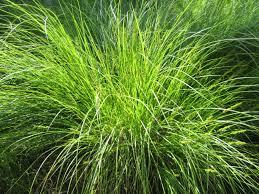Printed at http://www.newmoonnursery.com/index.cfm/
Carex vulpinoidea
Fox sedge
Native to North America
FIRST IMPRESSIONS: Carex vulpinoidea is a robust perennial sedge with dense tufts of soft grassy leaves. The delicate arching foliage is shiny, narrow, arching and often evergreen. Each plant produces several sturdy culms that are shorter than the foliage. In late spring the culms are topped by 5” stiff greenish inflorescences. The flowers transition into erect deep brown bristly seed clusters reminiscent of fox tails. This sedge thrives in sunny wet meadows or wet disturbed sites. In landscape situations, plants can serve as a lovely accent due to their fine textured foliage.
HABITAT & HARDINESS: Carex vulpinoidea is one of the most widely distributed sedges in North America. Plants occur in the southern Canadian provinces and in all of the contiguous U. S. states except Utah.
Plants are indigenous to openings in floodplain forests, sedge meadows, wet prairies, swamps, marshes, seasonally flooded sites adjacent to ponds, creeks and rivers, seeps, disturbed or degraded wetlands, wet fields and ditches. Carex vulpinoidea is the dominant sedge in some types of sedge meadows.
Hardy from USDA Zones 3-9.
PLANT DESCRIPTION: Carex vulpinoidea grows in lovely mounds of arching glossy foliage. Plants gradually form small colonies from short underground rhizomes.
Foliage is fine textured and light green. Blades are generally 3’long and a little over 1/8” wide. The narrow grass-like leaves are evergreen through most of the range.
In spring many culms rise to a height a bit shorter than the foliage. Each bears sturdy pencil shaped green flower spikes with needle like bracts. Seed form by late summer and spikes change to a pleasing deep brown color.
This sedge is 2-4’ tall with an equal spread.
CULTURAL & MAINTENANCE NEEDS: Carex vulpinoidea is a resilient sedge for wetlands and disturbed sites. Plants prosper in sun or part shade. Moist soil is preferred but plants will tolerate average soils, drought and wet sites.
This clump forming perennial is indigenous to both acid and alkaline soils and is adapted to heavy clay. Plants are competitive and in an ideal growing situation may become aggressive or invasive.
Plants are pest resistant and unpalatable to deer and other herbivores.
In garden situations, plants should be cut to the ground during late winter.
LANDSCAPE USES: Carex vulpinoidea is valuable for Wetland Restoration and Erosion Control in Bioswales and drainage ditches. Its ability to populate disturbed places makes this sedge a good choice to colonize wetland mitigation sites. Plants can be used to hold ground on various shorelines and are useful in Deer Resistant Plantings, Wet Meadows, Stormwater Projects and Wildlife Gardens.
COMPANION & UNDERSTUDY PLANTS: A few suitable companions for Carex vulpinoidea are: Aster punecius, Eupatorium maculatum, Eupatorium perfoliatum, Vernonia noveboracensis, Zizia aurea, Juncus effusus and Scirpus cyperinius.
Carex stricta is similar in appearance, height and cultural needs but is not as tolerant of disturbed sites.
TRIVIA: This sedge is very widely distributed across the United States and Canada.
Following disturbance it acts as a pioneer species and forms a valuable community service covering the ground and holding the soil.
Provides habitat and cover for birds and serves as a host plant for skipper butterflies.
Height:
2-4 ftSpread:
2-4 ftSpacing:
3-4 ftUSDA Hardiness Zone:
3-9Bloom Color:
Green, TanCarex vulpinoidea Characteristics
Attracts Wildlife
- Pollinators
- Songbirds
Attributes
- Naturalizing
- Dried Flower
- Cut Flower
Exposure
- Partial Shade to Full Sun
Deer Resistant
- Deer Resistant
Flowering Months
- June
Foliage Color
- Green
Grass Season
- Cool Season Grass
Juglans nigra Tolerance (Black Walnut)
- Yes
Season of Interest (Foliage)
- Spring
Soil Moisture Preference
- Wet to Moist
Interesting Notes:
For more information on this plant, visit the USDA PLANTS Database: http://plants.usda.gov/java/profile?symbol=CAVU2

